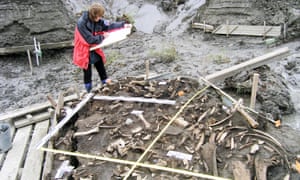Ancient Siberia was home to previously unknown humans

It was cold, remote and involved picking fights with woolly mammoths –
but it seems ancient Siberia 30,000 years ago was home to a hardy and
previously unknown group of humans. Scientists say the discovery could
help solve longstanding mysteries about the ancestors of native North
Americans.
While it is commonly believed the ancestors of native North Americans arrived from Eurasia via a now submerged land bridge called Beringia, exactly which groups crossed and gave rise to native North American populations has been difficult to unpick.
Now scientists say they might have found some answers to the conundrums.
Writing in the journal Nature, Eske Willerslev and colleagues reveal how they drew on existing data from modern populations as well as analysing ancient DNA from the remains of 34 individuals obtained from sites around north-eastern Siberia, dating from more than 31,000 years ago up to 600 years ago.
While it is commonly believed the ancestors of native North Americans arrived from Eurasia via a now submerged land bridge called Beringia, exactly which groups crossed and gave rise to native North American populations has been difficult to unpick.
Now scientists say they might have found some answers to the conundrums.
Writing in the journal Nature, Eske Willerslev and colleagues reveal how they drew on existing data from modern populations as well as analysing ancient DNA from the remains of 34 individuals obtained from sites around north-eastern Siberia, dating from more than 31,000 years ago up to 600 years ago.
The key remains were fragments of two tiny human milk teeth, shed by males, found at a place in Russia called Yana Rhinoceros Horn Site. First excavated in 2001, the site offers the earliest direct evidence of humans in north-eastern Siberia, with finds also including bone items and stone tools. Indirect evidence of human populations in north-eastern Siberia goes back to more than 40,000 years ago.
“What we see here is a much more complex story than what we believed was the case,” said Willerslev, director of the Lundbeck Foundation Centre for Geogenetics at the University of Copenhagen.
The results reveal these individuals were part of a previously unknown yet widespread group, dubbed the Ancient North Siberians by the team, who were genetically distinct from both Western Eurasians and East Asians. The researchers say they split off from the former 38,000 years ago – in other words, very shortly after Western Eurasians and East Asians themselves became genetically distinct. “They were living as big game hunters of woolly mammoth and woolly rhinoceros,” said Willerslev.
But, crucially, this population does not appear to be the direct ancestor of Native Americans.
Instead, analysis of the collection of genomes suggests the population that became the ancestors of native North Americans was the result of liaisons about 20,000 years ago between East Asians, who travelled north, and a group distantly related to the Ancient Northern Siberians. The East Asians also mixed with other descendants of Ancient Northern Siberians to give rise to another group, who the team dub the Ancient Paleo Siberians, who went on to supplant the existing group.
“[Ancestors of] Native Americans are not the first people in north-eastern Siberia as most people, if not everybody thought,” said Willerslev, adding that DNA recovered in north-eastern Siberia from what is believed to be an Ancient Paleo Siberian was crucial to the work. “This is the first evidence we have, real evidence, of something very close genetically to Native Americans,” he said.
The team add that one possibility is that the mixing involving the East Asians occurred in southern Beringia – one of the areas that could have offered respite from harshening conditions at the time.
They Ancient Paleo Siberians were themselves supplanted by another band of East Asians heading north about 10,000 years ago that gave rise to a group dubbed the “Neo-Siberians”. “The vast majority of the genetic makeup of present day Siberians comes from this last push,” said Willerslev. “This is also the reason you don’t have any very close connection between contemporary Siberians and Native Americans.”
John Hoffecker from the University of Colorado Boulder, who was not involved in the study, welcomed the research, saying a striking feature of the study is that humans were faring well in north-eastern Siberia, even in very difficult conditions, 30,000 years ago – with the genetic data from the teeth suggesting the males belonged to a population of about 500 people.
“That’s a pretty healthy population,” he said. “We had no idea 30 years ago that we had this robust healthy hunter-gatherer population thriving up in the high Arctic 30,000 years ago – it is amazing.”
Hoffecker added the presence of the group suggests it was the ice sheets in North America, not hostile conditions in Beringia, that kept people from reaching the Americas sooner.
Comments
Post a Comment